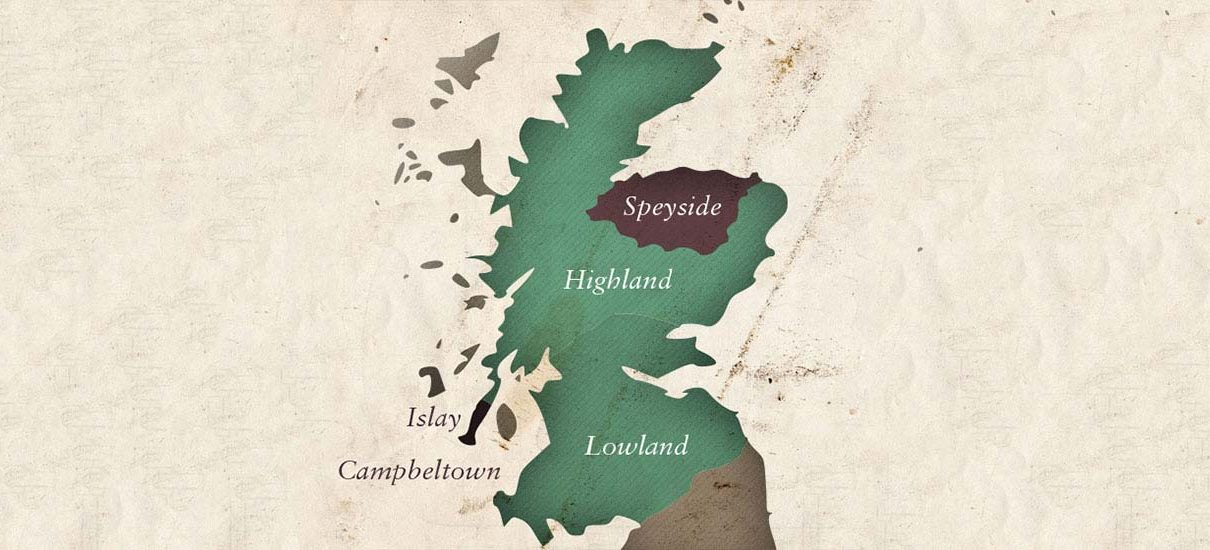
Scotland is home to more than 100 distilleries producing whisky that ranges in flavour from oily and peppery to delicate and floral. They are all made using the same underlying processes of fermentation, distillation, and maturation. So how can they taste so different? Where they are made is a big clue. Like fine wines, whiskies vary according to the scotch region.
There are five scotch whisky regions: Campbeltown, Highlands, Lowlands, Islay, and Speyside. The five regions cover different areas of Scotland and vary in size. They also produce different types of whisky, all with unique characteristics and in part, this is due to the landscapes of the regions and the water sources that the distilleries use. For instance, Speyside, where The Glenlivet is crafted, is served by the beautiful River Spey.
And if you’re wondering ‘are all scotches made in Scotland?’ the answer is yes. Whilst Scotch production isn’t confined to the five whisky regions of the country (although they are most well-known for their scotches), for a whisky to be classed as a scotch it has to be distilled and aged on Scottish soil.
So, if you’re heading to Scotland on a whisky tasting voyage or you simply want to know more about The Glenlivet region of Scotland and the home of our smooth scotch whisky, this guide to the five whisky regions in Scotland is sure to come in handy.

Speyside
As The Glenlivet region of Scotland, we think Speyside is the most beautiful part of the country. It’s certainly the most conducive to producing whisky. Our founder, George Smith, was the first licensed distiller to make whisky in Speyside in 1824, and now more than half of Scotland’s distilleries are based here. And who wouldn’t want to be? Speyside is all rolling hills and pine forest, with distilleries clustering loosely along the salmon-rich, crystal-clear waters of the River Spey. Plus, it’s known as one of the best single malt regions in the world.
Whiskies here tend to be rich, fruity, and floral, but some are light, sweet and youthful, and others are well sherried and thick.
Over the decades, single malts at The Glenlivet and most other Speyside whiskies have slowly evolved from being more robust and peaty to being sweeter and lighter. That’s how all our tastes have changed.
There are plenty of things to do in Speyside, so if you do decide to visit The Glenlivet distillery, we’d recommend staying for a few days so that you can enjoy sampling plenty of whiskies as well as all that the region has to offer, from stunning scenery to historical buildings.
Highlands
Scotland’s biggest region, stretching from the northwest of Glasgow up to the northern islands, features towering peaks, gentle glens, lochs, and coastal scenery. The large number of distilleries here produce a variety of styles, but overall, when it comes to Highlands vs Speyside, the whiskies tend to be more robust, spicy and intense here. The big flavours in Highland whiskies are a matter of tradition. Distilleries in other parts of Scotland, notably the Lowlands region, had access to plenty of barley and so developed big, tall stills that could produce large volumes of spirit. But in the Highlands, barley was scarce, so distilleries here only required smaller stills. Smaller stills allow oilier, heavier alcohols to move into the neck of the still and condense. These make the resulting whisky richer and more obviously flavoured.
Whiskies from areas within the Highlands region share further characteristics. Northern Highland whiskies are often full, rich, and cereal sweet, while those from the south are usually slightly lighter, drier and fruitier. Eastern Highland whiskies are full, dry, and very fruity, while the full and pungent whiskies from the west tend to be reminiscent of Islay varieties with their peat and smoke. A diverse bunch, indeed.
Lowlands
The Lowlands Scotch whisky region is in southernmost part of Scotland, close to the cities of Edinburgh and Glasgow. This makes it an easy region for whisky fans to take a trip to. Much of this region is situated within the basins of the River Clyde and the River Forth. The area is fairly flat, and formed of sedimentary rocks like sandstones and clay, but this means that vast greenery can be seen for miles.
Unlike in Speyside, there are only a few distilleries still working in the Scottish Lowlands region. Known more for its farming, the land here is wide and fertile, with vast fields ideal for cultivation bordered by low hills and patches of trees. Most Scottish distilleries, including The Glenlivet, double distil their whiskies. But in the Lowlands, whisky is traditionally triple distilled. This makes Lowland whiskies close in style to Irish whiskeys. The tall stills and lack of peat make for a lighter, more floral spirit. As they are usually quite mellow, they make a good aperitif.
Islay
Say the word “Islay” to most whisky aficionados and you’ll hear “peat” in response. This small island in the Inner Hebrides is flat and consists mainly of peat, which the distilleries use as fuel for malting barley. This adds a strong smoky, peaty flavour to the whisky, very different from most Speyside whiskies. The island is also lashed by sea winds and rain, and this has an impact on its whisky, too, in salty, seaweedy flavours.
Islay whiskies are known for being the strongest flavoured of all Scotch whiskies. It’s good to remember, though, that only half of the distilleries on Islay make peated whisky. Indeed, many of the locals drink unpeated or very lightly peated whisky. In the north of the island, you’ll find plenty of fruit and refinement – in the whisky and the locals.
Campbeltown
A scant few distilleries still operate in Campbeltown, which lies near the end of the Mull of Kintyre peninsula on the west coast. The whiskies here are very distinctive from Speyside and other regional Scotches.
The whiskies are full-bodied, with a depth of flavour and a slightly salty finish from the sea air making its way through the casks. The lack of trees on the Mull of Kintyre means they rely on peat, so smoky, vegetal flavours are also conspicuous.
Even with all these varieties across Scotland, there’s still only one place you can find the one that started it all: Glenlivet, Speyside. Home of The Glenlivet.
Want to learn more about whisky? Check out our fascinating whisky trivia. If you’re looking for more hands-on discovery, our whisky cocktail recipes and cooking with whisky guide will help you enjoy The Glenlivet any time.
